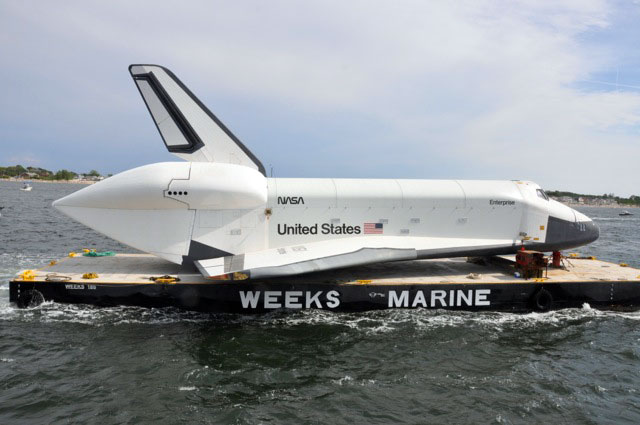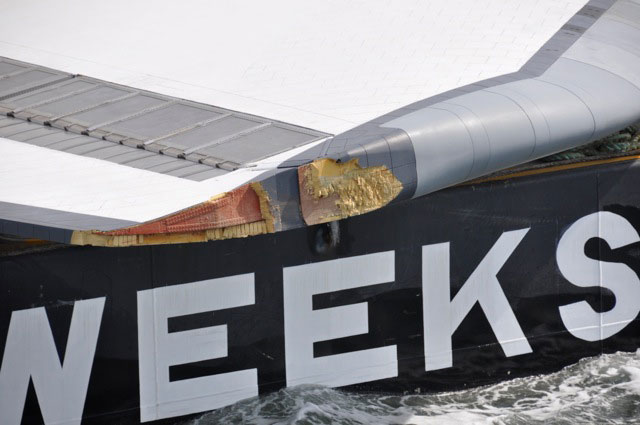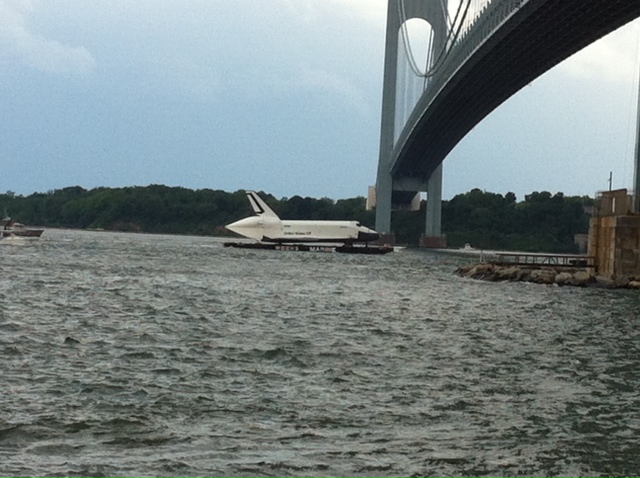Space Shuttle Enterprise Damaged at Sea as Weather Delays NYC Intrepid Trip

Space shuttle Enterprise suffered minor wing damage on Sunday (June 3) when it collided with the navigation guides for a New York railroad bridge during the first half of its sea trek to a Manhattan museum for display.
Mounted atop an open-air, flat-bed barge, Enterprise was on its way from John F. Kennedy (JFK) International Airport in New York to Weeks Marine in Jersey City, N.J., when the accident occurred. The shuttle, NASA's prototype for its orbiter fleet, was making the first leg of its trip to the Intrepid Sea, Air and Space Museum, a converted World War II aircraft carrier that is docked on Manhattan's west side.
The shuttle, which never flew in space but was used for a series of approach and landing tests in the late 1970s, was originally scheduled for delivery to the Intrepid on Tuesday (June 5) but poor weather conditions have delayed its departure until at least Wednesday, the museum said in a statement posted to its website.

Scraping by the bridge
It wasn't weather but a different type of hurdle that slowed the shuttle's arrival in the Garden State on Sunday. The shuttle needed to pass under several waterway crossings to reach Jersey City, including the South Channel Subway Bridge, as well as the Cross Bay Veterans Memorial, Gil Hodges Memorial, and Verrazano-Narrows bridges. [Final Voyage of Space Shuttle Enterprise (Photos)]
"The railroad bridge and the Cross Bay Bridge, each presented challenges," said Dennis Jenkins, who was on board the barge with Enterprise. "The passage through the railroad bridge was narrow with only a few feet of clearance on each wingtip, while the Cross Bay was only a few feet higher than the vertical stabilizer," he wrote in an e-mail that was shared with collectSPACE.
"Mother Nature did not smile on us. Just as the barge entered the railroad bridge, the wind caught it and pushed the right wing into the bridge abutment. Fortunately, the damage seems to be cosmetic, limited to the foam that covered the wingtip. No structure or mechanisms appear to have been damaged," Jenkins wrote.
Get the Space.com Newsletter
Breaking space news, the latest updates on rocket launches, skywatching events and more!
Jenkins' photos of the damage, which were also shared with collectSPACE.com, show Enterprise as it neared the bridge's navigation aid wooden bumpers. The shuttle's right wing scraped along the bridge barrier, which caused foam chunks to break away from the leading edge of Enterprise's elevon, or flap.
The Intrepid confirmed the damage in a statement released late Sunday.
"A sudden microburst of wind, measured at 35 knots, caused the rub panel foam protective layer of the wingtip of Enterprise to graze the protective wood piling bumpers in the water designed to bumper vessels," the museum said.
Despite the damage, the space shuttle continued on its way to New Jersey with little pause.

"The Cross Bay provided a few heart-stopping seconds, but that was mostly because we were gun-shy after the incident at the railroad bridge (the two bridges are only a few hundred yards apart)," Jenkins wrote. "The rest of the journey was completed without incident."
Enterprise arrived at Weeks Marine on Sunday evening, after it was already dark.
"We will [on Monday be able to] better assess the wingtip damage (it was late by the time we docked, with almost no light available)," Jenkins wrote.
Delayed departure
Enterprise was originally scheduled to switch barges on Monday, to one equipped with a crane to hoist the shuttle onto Intrepid's flight deck. The weather however, did not cooperate with moving the orbiter.
"The planned final leg of the journey of space shuttle Enterprise to its new home at the Intrepid Sea, Air and Space Museum has been postponed due to inclement weather which is delaying the prep work necessary to ferry and crane the shuttle to its final destination," the Intrepid advised in a statement. "A new moving date has been tentatively set for Wednesday, June 6."
Enterprise's moves, whether it is between barges or to the Intrepid, are dependent on weather and tidal conditions, the museum said.
The delay to Enterprise's arrival is not expected to affect the public opening of the Intrepid's new "Space Shuttle Pavilion," which remains set for July 19.
See more photos of Enterprise's Sunday barge trip here and visit shuttles.collectspace.com for continuing coverage of the delivery and display of NASA's retired space shuttles.
Follow collectSPACE on Facebook and Twitter @collectSPACE and editor Robert Pearlman @robertpearlman. Copyright 2012 collectSPACE.com. All rights reserved.
Join our Space Forums to keep talking space on the latest missions, night sky and more! And if you have a news tip, correction or comment, let us know at: community@space.com.

Robert Pearlman is a space historian, journalist and the founder and editor of collectSPACE.com, a daily news publication and community devoted to space history with a particular focus on how and where space exploration intersects with pop culture. Pearlman is also a contributing writer for Space.com and co-author of "Space Stations: The Art, Science, and Reality of Working in Space” published by Smithsonian Books in 2018.In 2009, he was inducted into the U.S. Space Camp Hall of Fame in Huntsville, Alabama. In 2021, he was honored by the American Astronautical Society with the Ordway Award for Sustained Excellence in Spaceflight History. In 2023, the National Space Club Florida Committee recognized Pearlman with the Kolcum News and Communications Award for excellence in telling the space story along the Space Coast and throughout the world.










